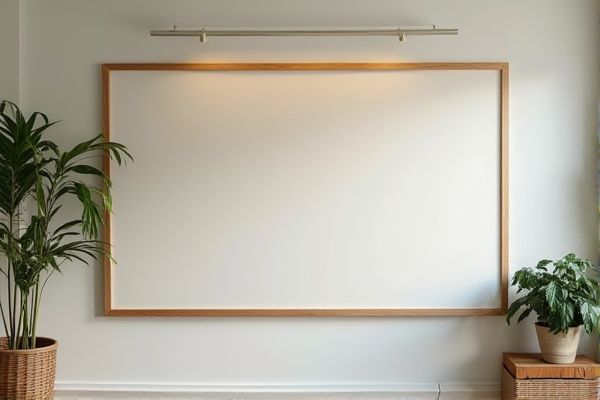
Tackboards are typically covered with fabric and designed for use with push pins or tacks, offering a softer surface ideal for holding lightweight items securely without damaging walls. Pinboards, often made from cork or similar materials, allow pins to be easily inserted and removed, providing a practical solution for organizing notes, photos, or reminders; discover which option best suits Your needs by reading the rest of the article.
Table of Comparison
| Feature | Tackboard | Pinboard |
|---|---|---|
| Definition | Board used to attach items using tacks or push pins. | Board designed for pinning notes, photos, or reminders. |
| Material | Usually cork or foam backing. | Typically cork, fabric, or felt surface. |
| Attachment Method | Tacks or push pins. | Push pins or sewing pins. |
| Common Uses | Offices, classrooms, workshops for displaying documents. | Home, offices, and creative spaces for notes, photos, inspiration. |
| Durability | Moderate; tacks can wear out the board over time. | Moderate to high; fabric pinboards last longer. |
| Portability | Usually wall-mounted; portable versions exist. | Wall-mounted or portable; often lightweight. |
Understanding Tackboards and Pinboards
Tackboards and pinboards are versatile surfaces designed for organizing notes, reminders, and important documents using pins or tacks. Tackboards typically feature a softer cork material allowing easy insertion and removal of pushpins, whereas pinboards often incorporate harder materials or fabric surfaces suitable for pins or needles. Understanding the differences helps you choose the right board for your workspace, ensuring efficient display and accessibility of your information.
Key Differences Between Tackboards and Pinboards
Tackboards use push pins or tacks to attach notes or items, providing a firm hold on materials such as paper or fabric, while pinboards typically use pins that may be smaller and more delicate, suitable for lighter items. Tackboards often feature a thicker cork or foam core, offering greater durability and the ability to withstand repeated pinning, whereas pinboards may have a thinner surface and are commonly used for decorative or lightweight display purposes. The choice between tackboards and pinboards depends on the required durability, the weight of materials to be displayed, and the intended aesthetic or functional use in offices, classrooms, or homes.
Materials Used in Tackboards vs Pinboards
Tackboards commonly feature materials such as cork or foam backed with fabric to allow easy insertion of pins and tacks without damaging the surface. Pinboards often utilize denser materials like cork, felt, or woven fibers, designed to securely hold various types of pins while maintaining durability over extended use. The choice of materials directly influences the board's functionality, with tackboards favoring softer, penetrable surfaces and pinboards prioritizing sturdiness and longevity.
Best Applications for Tackboards
Tackboards excel in organizing visual information in classrooms, offices, and creative studios due to their durable fabric surfaces that securely hold pushpins without damage. Their resilience against frequent pinning and re-pinning makes them ideal for displaying rotating project updates, reminders, and inspirational materials. You will find tackboards particularly beneficial for environments requiring dynamic, reusable displays where quick changes and frequent updates are common.
Ideal Uses for Pinboards
Pinboards are ideal for organizing lightweight documents, photos, and reminders, making them perfect for home offices or classrooms. Their fabric or cork surfaces allow for easy repositioning of items using push pins, supporting dynamic and interactive displays. These boards enhance visual communication and creativity in spaces where frequent updates are essential.
Pros and Cons of Tackboards
Tackboards provide a versatile surface for pinning notes, reminders, and lightweight items, making them ideal for office and classroom environments. Their fabric-covered design allows for easy tacking and repositioning, but they may wear over time and aren't suitable for heavy or sharp objects. Your choice depends on whether you prioritize ease of use and flexibility or durability and surface hardness.
Advantages and Disadvantages of Pinboards
Pinboards offer a versatile and reusable surface for organizing notes, photos, and reminders with easy attachment using pins, making them ideal for dynamic environments like offices and classrooms. Their primary advantage lies in their durability and the ability to rearrange items without causing damage. However, pinboards can be bulky, limited in color options, and may cause wear on pinned materials over time compared to tackboards.
Cost Comparison: Tackboards vs Pinboards
Tackboards typically offer a more cost-effective solution than pinboards, with prices ranging from $20 to $80 depending on size and material. Pinboards often cost more due to higher-end finishes and durable cork surfaces, averaging between $40 and $120. Budget-conscious buyers favor tackboards for basic use, while pinboards provide added longevity justifying their higher price point.
Maintenance and Durability Considerations
Tackboards typically feature self-healing surfaces made from materials like cork or foam, which require minimal maintenance and resist wear from repeated pinning, ensuring long-term durability. Pinboards often use fabric or softer materials that may show pinhole marks and fray over time, necessitating occasional replacements to maintain a neat appearance. Choosing the right board for your space depends on balancing your need for low upkeep with the board's expected lifespan and usage frequency.
Choosing the Right Board for Your Needs
Choosing between a tackboard and a pinboard depends on your specific needs for durability and aesthetics; tackboards typically feature a soft, fabric-covered surface ideal for frequent use, while pinboards often use cork, offering a natural look but softer resistance. If you require a board for heavy-duty or repetitive pinning, a tackboard's resilient surface maintains its integrity longer, preserving your important notices and memos. Your decision should consider the environment, style, and how often you plan to update or rearrange items on the board.
 homyna.com
homyna.com